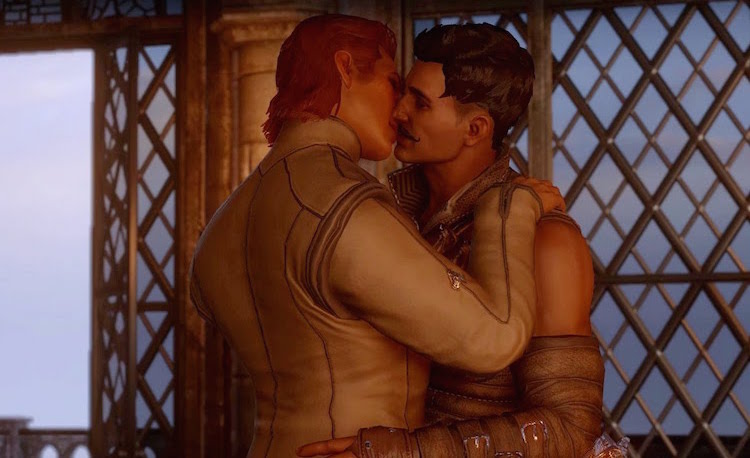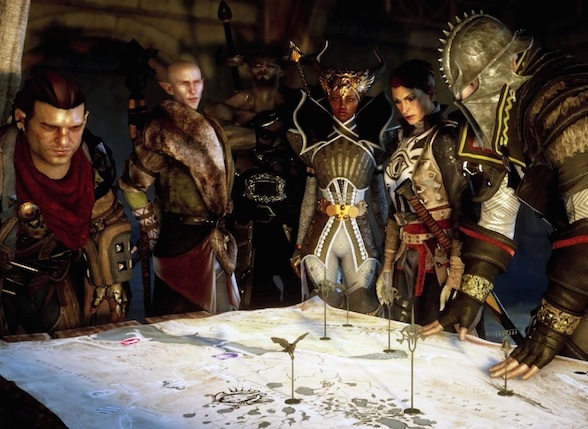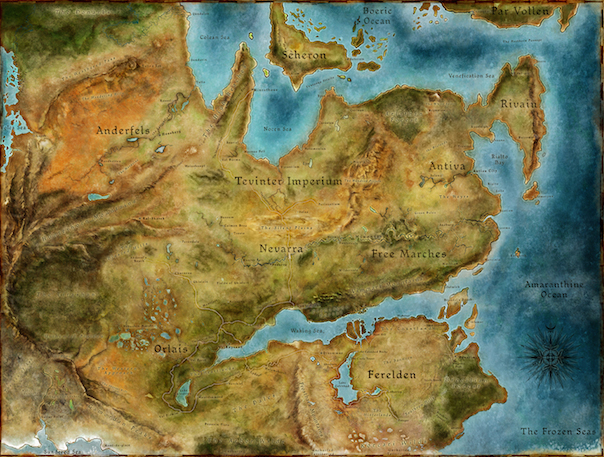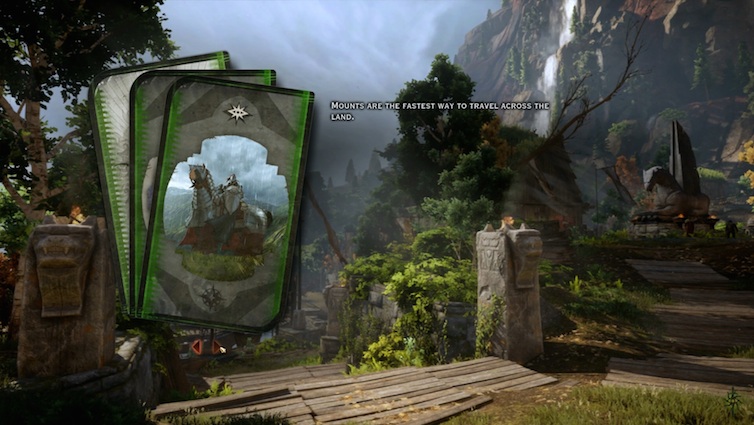As a company, Canadian-based game developer BioWare has been famous for its attempts at inclusivity of minority characters in its video games. Through the years, most notably in its two most famous properties, the Mass Effect and Dragon Age series, BioWare’s concern with inclusivity has been centered largely around that of minorities on the sexuality and gender spectrums. These attempts at inclusivity have been earned the studio commendations for their progressivity and forward-thinking, as well as appreciation from fans for targeting a somewhat atypical triple-A gaming audience—that is, people who are not heterosexual, cisgender men. Perhaps the most prominent example of BioWare’s efforts at representation is its most recent major publication, Dragon Age: Inquisition.
Of the three major Dragon Age titles published so far, Inquisition, released in November of 2014, is undoubtedly the most inclusive when it comes to gender and sexuality. While Dragon Age: Origins (2009) and Dragon Age II (2011) featured multiple straight and bisexual characters, Inquisition is the first of the three to feature not only gay and lesbian characters, but also a character who falls outside of the traditional male-female binary on the gender spectrum. For all that is laudable about its effort at greater inclusivity, however, Inquisition is not without its representational problems, and indeed the game’s approach to gender and sexuality has not met with unanimous praise from players. The game’s mixed reception in this regard is telling, for ultimately it stems from a problematic aspect of Inquisition‘s design: despite BioWare’s attempt to construct a universe equally inclusive of all sexualities and genders, their inclusivity comes across as more of an artificial construct, forced into the game, rather than a naturally occurring, organically integrated component.
Before examining the game’s reception in more detail, it is important to understand how BioWare and the Dragon Age franchise in particular came to develop such a positive reputation for inclusivity, and how the inclusion of romance has both created and escalated the attention drawn to the issue of representation in BioWare’s games. Historically, the company’s games have been popular with fans because they allowed players to initiate romantic relationships with certain characters in the games—a feature that was first included in Baldur’s Gate 2 (2002). However, as David Gaider, Lead Writer for a number of BioWare games, has explained, until the release of Jade Empire (2005), BioWare’s character romance options had remained strictly heterosexual. Even after romances for players and characters of the same gender were included, it wasn’t until the Mass Effect and Dragon Age franchises (which are BioWare’s most famous) that the company began gaining attention and publicity for their bisexual characters. To date, almost no other franchises have included “romance options” in the same manner that BioWare has, with a focus on the characters and emotions instead of romance as an achievement or merely a quasi-cosmetic option, as it is in such RPGs as Bethesda’s The Elder Scrolls V: Skyrim (2011). Through BioWare’s character romances, the player is allowed to learn more about what makes the romanced character unique within the context of the game’s universe, which allows for a unique mode of immersion.

The Mass Effect player character, Shepard, and one of the bisexual romance options, Liara T’Soni, in Mass Effect 3.
Yet another layer of complexity is added to this feature when queer characters become involved—not only for the gameplay, but also for the developer and their fans. Like any traditional role playing game, the Dragon Age universe contains a significant amount of world building, and through the character romance system that BioWare created, they were able to construct an entire queer-inclusive social hierarchy, which the player learns about through dialogue and information in books scattered throughout the game world. The sheer size and intricacy of Thedas, the fictitious continent in which Dragon Age takes place, lends itself well to world building of every variety, and the inclusion of queer lore in the universe is done so in a credible, believable manner, which appeals to fans on many levels. Journalist David Silver, writing for VentureBeat, cites Inquisition’s characters, namely Sera (an elven rogue) and the Iron Bull (a qunari warrior), as being realistic and flawed, having “their own struggles, their own desires, their own motivations and backstory.” In other words, BioWare’s queer characters are presented as characters, rather than as tokens offered for the sake of being politically correct.
Because the integration of queer characters has been done so prominently in the Dragon Age franchise, as the franchise has developed, so has BioWare’s inclusiveness. What began as two bisexual characters, Leliana and Zevran, in Origins was raised to four (that is, every romance option) in Dragon Age 2. And in Inquisition, BioWare presented its most diverse cast of potential characters—and potential romance options—yet. Of them, four are straight (Cullen Rutherford, Solas, Blackwall, and Cassandra Pentaghast), one gay (Dorian Pavus), one lesbian (Sera), and three bisexual (Iron Bull, Josephine Montilyet, and Lace Harding). Among these romance options in Inquisition, six are characters who can accompany the player character, the Inquisitor, as party members when exploring and fighting in various parts of Fereldan and Orlais, the two countries in Thedas where the game is set. Two of the remaining three, Cullen and Josephine, act as advisors to the Inquisitor, while Harding is an Inquisition foot soldier and scout, and can only be interacted with at specific intervals during the game. The presentation of queer characters as both party members and romance options ensures that they play an active role in the game, at least so far as the player chooses to interact with them outside of story segments where they prominently affect the plot.
In addition to including more (and a greater variety of) queer characters than Origins and Dragon Age 2, Inquisition did a number of other things better than its predecessors. The greater variety of queer minority characters has been lauded by numerous critics, including GLAAD, which recognized Inquisition with a special award at its 26th Annual GLAAD Media Awards. Another aspect that Inquisition improved on was Dragon Age 2’s “player-sexual” characters. Though arguably Dragon Age 2 was inclusive because of its high number of presumably bi- or pansexual characters, as all four of its non-downloadable content romance options were available to a player character of either sex, this also created a conundrum for players who wished to see greater development with characters’ own sexualities and stories. As game scholar Stephen Greer, writing on Dragon Age 2, explains, “While a ‘sexuality blind’ approach to game design may free creators from the burden of attempting to create an extended range of…characters and narrative variations…it also affirms a separation of the cultural politics of design choices from those of the wider world….[S]uch positioning also articulates a preference for models of inclusivity that preserve and privilege the status quo.” Though opinions differed, as the Dragon Age community is fairly expansive and diverse, many players expressed similar opinions, and were grateful for the change in Inquisition. Making every romance option “player-sexual” arguably deprived the characters of some autonomy, which Inquisition addressed and strove to fix. Inquisition’s romance options were all different and the characters had different sexualities, which gave them more of a sexual identity than their predecessors in Dragon Age 2.

One of Dragon Age: Inquisition’s heterosexual romance options, Cassandra Pentaghast, is also a fearsome warrior under oath of the Seeker order.
A third aspect that Dragon Age: Inquisition improved on was including characters, especially romanceable characters, of different genders. In previous games, there had been an equal number of male and female romance options for players to pursue, and for the most part, there had been a balance in sexualities of these characters—two straight and two bisexual in Origins, with all four being bisexual in Dragon Age 2—making it easy for player characters of any sex and sexuality to pursue a romance. In Inquisition, however, in addition to including a greater variety of sexualities, there are more potential romance options for a straight female Inquisitor than there are for a straight male, which confronted a long-standing concern in the video game industry that games are not marketed toward minority players (i.e. anyone who is not young, heterosexual, cisgender and male).
Dragon Age lead writer David Gaider addresses this in a conference talk he gave regarding the turn away from sexism and sexuality in BioWare’s games. According to Gaider, minority players “…play our games….but it’s not because anyone invited them to play. In fact, in a lot of cases, it’s clear that they play despite it being made plainly obvious to them that they’re not the intended audience.” He continues on to ask his viewers what would happen if developers decided to acknowledge what he calls an “untapped audience,” and to answer this this question points to Inquisition, which had not yet been published at the time of the talk. It is cases like this that have given BioWare its reputation for being inclusive, because they as a developer have taken active steps to combat the latent sexism in the industry by ensuring that their audience is not just straight, cis men.
In addition to their inclusions of romance options for minority players, BioWare also included the second transgender character in the Dragon Age franchise, Cremisius “Krem” Acclassi. The player learns through dialogue that he is biologically female, though he identifies as male. Although Krem is not a playable character or a romance option, he is a fairly significant character, whom players have expressed an active interest in, and his inclusion was a statement of BioWare’s trans-inclusivity, which has helped attract queer players to the game. Through targeting a fanbase of female and queer players as Inquisition did, BioWare was able to reach out to their minority audience through the game, and make the statement that they, as a company, valued their fans, and took every step necessary to make sure that they felt as included (or even more included) than their straight male audience did.
Perhaps the most positive result of the greater diversity of sexualities in Inquisition is the ability for players of all types to express themselves more freely through the character romance system. While romances are not necessary for the game’s central plot or quests, the fact that the option—specifically the option for queer romance —exists is an achievement for BioWare in inclusivity. Creating background and side characters, and even major characters as queer is one thing, but allowing the player to play as a queer character and choose their Inquisitor’s sexuality reframes the video game as a privileged medium for the safe expression of (and experimentation with) sexuality.
Although BioWare’s achievements in this regard deserve praise, there is still much that can be improved on for the future of the Dragon Age franchise. Inquisition is frequently cited as being one of, if not the most inclusive game(s) on the market, but it is not difficult to earn that achievement if most other game developers are not actively competing for it. While BioWare’s inclusivity is certainly a step forward, it is only one of many steps needed to make the gaming industry a place that can be dubbed inclusive.
One of the largest points of contention regarding Inquisition’s queer characters was Dorian’s personal quest which, according to some members of the BioWare community, was akin to the stereotypical “gay” stories featured in most other media. In this quest, the Inquisitor learns of a plot by Dorian’s father, magister Halward Pavus, to allegedly abduct his son and bring him back to Tevinter, his home country. After informing Dorian of this plot, the mage suggests that the Inquisitor accompany him, and the two travel to meet Halward, whose true intentions were simply to talk to his son and express his thoughts and feelings about Dorian’s sexuality and the rift it caused between them. Although this meeting turns out to be harmless, the Inquisitor learns numerous details about Dorian’s past, including that his father attempted to change his sexuality through a magic ritual. As one fan put it on the BioWare forums, “I’m a little disappointed that his personal mission was solely based on him being gay,” and many other commenters in the thread expressed the same opinion.
Although Sera has received much less attention, despite being the only other strictly gay character in the franchise thus far, there are stereotypical elements to her, as well. At one point, if the Inquisitor has a strong friendship with her, she will reveal that she feels as if she never fit in with other elves and was brought up by humans, which only adds to the common “misunderstood, angry lesbian” trope that has become all too popular in media representing the queer community. As Jillian, a blogger for FemHype, argues, “Sera comes off more like the widespread cocktail of self-righteous anger and incoherent babbling that make up your token lesbian character than an actual human being.” Jillian also highlights some of Sera’s arguably transphobic dialogue and questions why, if BioWare is meant to be such an inclusive company, they included so much dialogue related to the policing of genitalia?

Sera is Dragon Age: Inquisition’s sole lesbian romance option.
In addition to the story’s two gay characters being stereotyped, BioWare’s inclusion doesn’t quite extend to all sexualities. One of the largest examples of this is in the character of Cole, who is a spirit-like party companion who cannot be romanced by the Inquisitor. Arguably, this lack of romantic interest from Cole could be grounds for representation of asexual and aromantic individuals, whose orientations are too often skimmed over by the media and belittled to the point that many believe that these are not valid sexualities with which to identify. However, any hope of asexual/aromantic representation in Cole’s character was snuffed in the downloadable-content ending to the game, Trespasser. Late in the main story of Inquisition, the Inquisitor has the option to either make Cole more “spirit-like” or more “human,” which will affect how others view him for the remainder of the game. If they choose to make him more human, an interaction between him and Maryden, the game’s tavern bard, will occur in which he kisses her cheek and remarks that her songs make people happy. Up until the release of Trespasser, many fans had been happily projecting Cole as asexual and/or aromantic, a conclusion which made sense given his apparent lack of romantic and sexual interest in any other characters. However, during Trespasser, a more human Cole even exchanges the following dialogue with Dorian:
DORIAN. You have a lady friend?
COLE. Well, I am human now.
Kyra S., another writer for FemHype, observed that this dialogue made her feel as though she was “clearly not human.” “I want to be happy for Cole,” she explained, “but I kind of feel like Bioware is taking a shot at me. I know I shouldn’t expect representation but the fact that it’s Cole saying it makes it particularly cruel.” Until this dialogue was revealed, BioWare’s attempts at inclusivity had, on the surface, looked incredibly positive. Through Cole, they had apparently targeted a portion of their fans who still receive little to no attention from most media texts, and it had worked—until Trespasser. The ignorance contained in their creation of yet another needless romantic subplot was, this time, a reflection of the lack of attention that the asexual and aromantic community receives every day. Though probably not their intent, BioWare successfully alienated a portion of its players by essentially stating that they did not care about their sexuality or romantic orientation.
Another area in which people took issue with Inquisition was, surprisingly, in its romantic dialogue options. Players generally have no issue with the options which lead to an actual romantic relationship with one of the characters, but there is a baffling gray area contained in the romantic options with characters an Inquisitor cannot romance—for example, a female Inquisitor can flirt with both Dorian and Cassandra, despite neither of them being romantically or sexually attracted to women. It is only after this occurs multiple times that the character in question will attempt to set the Inquisitor straight and explain that they are not attracted to the player’s character.
The purpose of including these “flirt” options is unclear to many, and in some instances it even feels unfair to the characters being flirted with. For instance, a female Inquisitor can flirt with Dorian (who, to be fair, does enjoy flirting as a rule), but after the quest in which he encounters his father, he admits to the Inquisitor that he is gay and not interested in women. As a result, if the player chooses, the Inquisitor can accuse Dorian of having “led her on,” which seems like a potentially hurtful thing to say to a man who just had either a touching reunion with his father or a violent parting of ways, depending on the choices made during the scene. In a similar vein, the player can also inquire about Krem’s gender by either talking with him or to his boss, Iron Bull; the player can then ask a series of questions, or refer to Krem as a woman, which comes across as an extremely transphobic choice in a game where the developer has actively framed their game in terms of inclusivity. On the one hand, it can be argued that these choices add an element of unfortunate reality to the game; but on the other, having the player character play a queer-phobic person in the game is incredibly problematic. At the very least, it doesn’t promote the “equality” that BioWare is so concerned with achieving.
With all of these factors—both positive and negative—in mind, can Dragon Age: Inquisition really be considered a game equally inclusive of all sexualities, romantic orientations, and genders? The answer, undoubtedly, is no it cannot. With so many different types of people in the world, one could argue that it is even impossible to satisfy everyone with just one game, as the inclusion of so many different identities would surely raise issue with at least one person, even if the majority has given its approval. In spite of the game’s failings, though, it is important to remember that BioWare is still doing more as a company to combat majority privilege and include as many minority groups as they can.
In one incident, which has become something of an infamous internet spectacle, a gamer, stating that he spoke for all “straight male gamers”—whom he dubbed the target audience of video games—called out BioWare on their message boards for the company’s inclusion of so many bisexual characters in Dragon Age: Origins and Dragon Age 2. In response, lead writer David Gaider essentially told him to find another company who actually felt it necessary to listen to his complaints. Gaider wrote, “The romances in the game are not for ‘the straight male gamer.’ They’re for everyone. We have a lot of fans, many of whom are neither straight nor male, and they deserve no less attention.” He later received a reply from the same individual who attempted to clarify his point, but Gaider’s conclusion made it perfectly clear that BioWare was ready and willing to listen to all of its fans, not merely the straight, cisgender male ones. “The person who says that the only way to please them is to restrict options for others is, if you ask me, the one who deserves it least,” Gaider wrote. “And that’s my opinion, expressed as politely as possible” (for a full transcript of the exchange, check out Krissie Pearce’s piece on No More Lost). His response is telling; many other game developers would not express such a vested interest in ensuring that all of their players are happy, and it is this intent that sets BioWare apart from the rest of the gaming community.
That said, BioWare’s games still have a long way to go before they are truly inclusive. As it stands now, using Inquisition as an example, the company’s inclusivity feels like more of an intentional construct rather than something organic. In other words, the writing of the story and characters did not naturally result in a diverse cast in terms of gender and sexuality; rather, the diversity was—in part, it seems—artificially imposed. This creates a tension between BioWare’s need to include characters of all sexualities and genders and their commitment to the art of storytelling. In fact, it can even hinder storytelling if the goal of inclusivity is paid more attention to than the development of the story itself. There can be no mistaking that Inquisition has a good story and has intrigued many gamers, and that its inclusivity is groundbreaking for an industry which has paid too little heed to gamers who fall outside of the straight, cis male category. In the future, however, the key to creating more successful, inclusive games will be, paradoxically, finding a balance between telling an organic, epic story and being inclusive.





Recent Comments